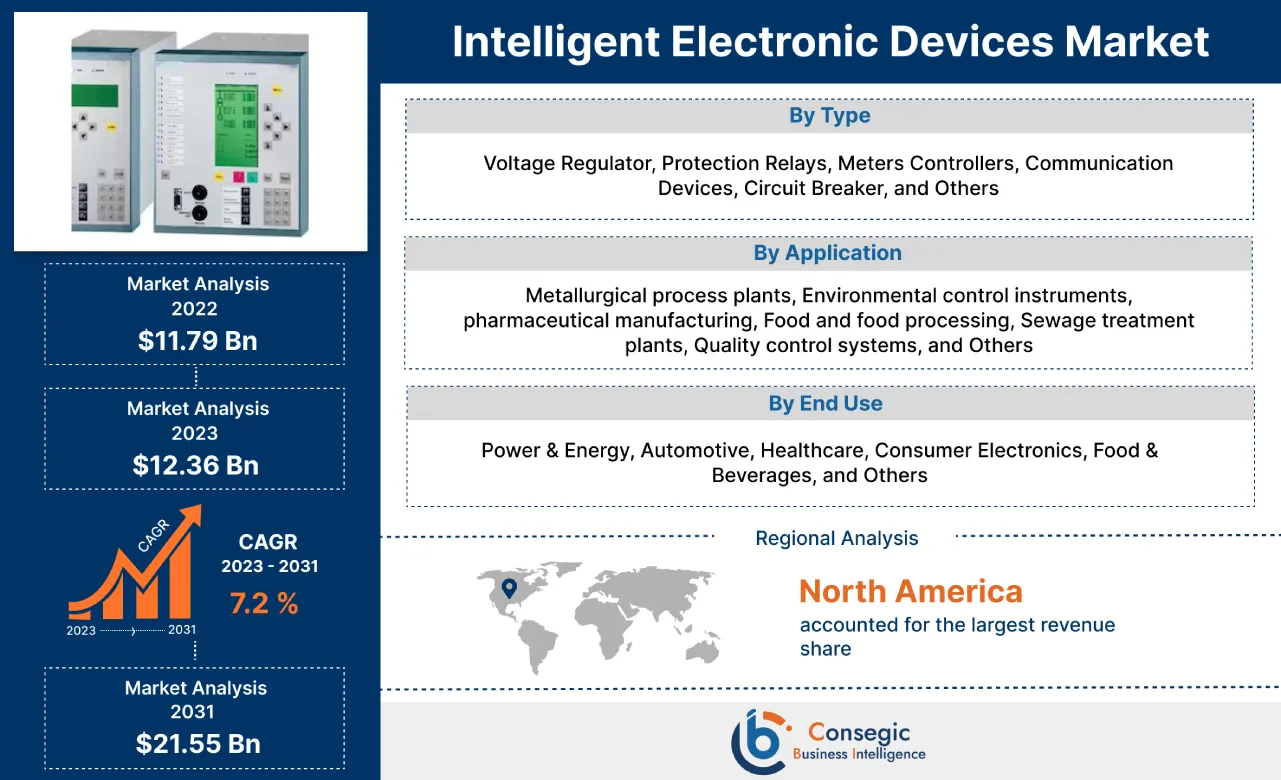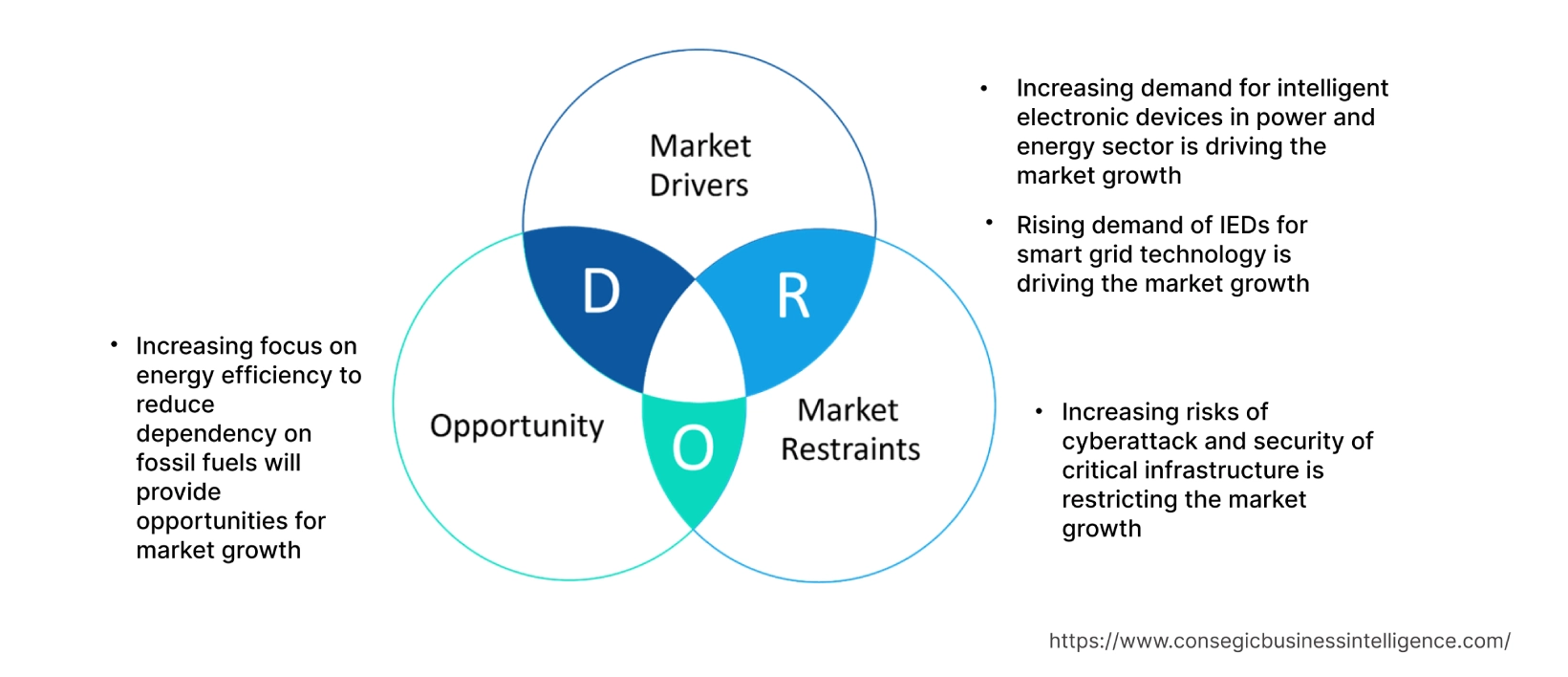- Summary
- Table Of Content
- Methodology
Intelligent Electronic Devices Market Size :
Global Intelligent Electronic Devices Market Size is estimated to reach over USD 21.55 Billion by 2031 from a value of USD 11.79 Billion in 2022 and is projected to grow by USD 12.36 Billion in 2023, growing at a CAGR of 7.2% from 2023 to 2031.
Intelligent Electronic Devices Market Scope & Overview:
Intelligent electronic devices (IEDs) are commonly termed as a group of electronic devices incorporated into Industrial Control Systems (ICS) structures that allow variable power automation capabilities. These are mainly electric components with microprocessors including regulator devices and circuit controllers. In addition, they are employed in varied industrial control systems including SCADA (Supervisory Control and Data Acquisition) and DCS (Data Collection System). Moreover, they have applications including power quality analysis, network monitoring, energy metering, and for protection purposes.
Intelligent Electronic Devices Market Insights :
Key Drivers :
Increasing demand in the power and energy sector.
The requirement for IEDs in the power and energy sector is growing rapidly due to the increasing need for reliable, efficient, and secure power grids. They are used to monitor, control, and protect power grids, and are essential for ensuring the safe and reliable operation of grids. In addition, renewable energy sources including solar and wind power are becoming increasingly popular owing to environmental concerns.
Moreover, IEDs help to integrate renewable energy sources into the grid by providing flexibility and control. Smart grids are power grids that utilize digital technologies to improve efficiency, reliability, and security. They are an essential part of smart grids, as they can collect and process data from sensors and other equipment, and issue control commands to optimize the operation of the grid. Additionally, governments are increasingly imposing regulations on power quality and emissions due to the rising nature of carbon dioxide in the environment. They therefore help to comply with regulations by monitoring the grid for violations and taking corrective action. Analysis of market trends concludes that key factors attributed to the increase in their use include increased integration of renewable energy sources, reduced operational costs and enhanced security of power grids are driving the intelligent electronic devices market demand.
Rising demand for smart grid technology.
The requirement for IEDs is growing in response to the increasing need for grid stability and reliability, more efficient energy use, integration of renewable energy sources, and improved security. They are essential components of smart grid technology as they play a vital role in improving the efficiency, reliability, and security of the grid. They are designed to monitor and control grid assets, protect the grid from issues, communicate with each other and other devices on the grid, and optimize the operation of the grid. Their key applications in smart grids include monitoring the status of transformers, substations, and power lines. The information obtained is further used to identify potential problems and determine corrective action before an outage.
Moreover, they are used to communicate with each other and with other devices on the grid, including smart meters and renewable energy sources. This allows for real-time monitoring and control of the grid. In addition, their efficiency in balancing supply and demand for electricity also helps to reduce energy losses. Analysis of market trends concludes that due to the aforementioned factors, their requirement is increasing and is being adopted by the smart grids resulting in driving intelligent electronic devices market demand.
For instance, according to the International Energy Association, the deemed requirement for distributed solar PV is increasing and was accounted to have fulfilled 48% of the energy requirements by residential, industrial, and commercial sectors during the year 2022.
Key Restraints :
Increasing risks of cyberattack and security of critical infrastructure.
Intelligent electronic devices are essential components of critical infrastructure including water treatment plants, power grids, and transportation systems. IEDs are used to monitor and control systems, further systems are connected to the internet which raises the vulnerability to cyberattacks. In addition, cyberattacks are devised for physical damage to them or the system it controls. Also, a rise in chances of a blackout increase due to the disabling of a power station by an attacker causing losses to the government.
Moreover, a cyberattack attempts to steal sensitive data from an IED, such as passwords, encryption keys, or control settings. Further, data is used to launch further attacks or to disrupt the operation of the system. Furthermore, a cyberattack interferes with the communication between them, resulting in difficulty or impossible to control the system. Therefore, owing to the aforementioned conditions generated by cyberattacks and higher chances of vulnerability is restraining the growth of the market.
Future Opportunities :
Increasing focus on energy efficiency to reduce dependency on fossil fuels will provide opportunities.
Intelligent electronic devices are expected for applications to improve energy efficiency by reducing dependence on fossil fuels. Owing to the growing concern of depleting natural resources and excessive utilization of fossil fuels, the need for non-renewable resources is expected to rise shortly. In addition, IEDs will be used to monitor the energy consumption of appliances, buildings, and other devices. Further, information obtained from them will help to identify opportunities for energy savings and to control energy usage.
Moreover, their application as smart thermostats to conserve energy is emerging as one of many intelligent electronic devices market opportunities that will drive market expansion during the forecast period.
Intelligent Electronic Devices Market Report Insights :
| Report Attributes | Report Details |
| Study Timeline | 2017-2031 |
| Market Size in 2031 | USD 21.55 Billion |
| CAGR (2023-2031) | 7.2% |
| By Type | Voltage Regulator, Protection Relays, Meters Controllers, Communication Devices, Circuit Breaker, and Others |
| By Application | Metallurgical process plants, Environmental control instruments, pharmaceutical manufacturing, Food and food processing, Sewage treatment plants, Quality control systems, and Others |
| By End Use | Power & Energy, Automotive, Healthcare, Consumer Electronics, Food & Beverages, and Others |
| By Region | North America, Europe, Asia-Pacific, Latin America, and Middle East & Africa |
| Key Players | Hitachi Energy Ltd., Rockwell Automation Inc., Toshiba Corporation, Black & Veatch Corporation, Eaton Corporation Inc., Schneider Electric, Cisco |
Intelligent Electronic Devices Market Segmental Analysis :
By Type :
Based on the type, the market is divided into voltage regulators, protection relays, meter controllers, communication devices, circuit breakers, and others. In 2022, the Protection relays segment accounted for the highest intelligent electronic devices market. The intelligent electronic devices market analysis concluded that the key factor attributing to the growth of the segment is the advantage offered by protection relays in ensuring the safety of power grids and other critical infrastructure. Protection relays are employed to detect and isolate faults, which prevent damage to equipment and loss of power. In addition, protection relays are used to detect and isolate faults in power grids coupled with ensuring the safety of power grids and preventing damage to equipment and loss of power. Assessment of market trends suggests that the requirement for protection relays is expected to remain high in the future.
Furthermore, the communication devices type segment is anticipated to grow at the fastest growth rate during the forecast period. Communication devices are essential for connectivity and are used to transmit data and control signals between IEDs. Examination of market trends concludes that they are increasingly connected to communication devices and other systems, including smart grids and SCADA systems, and are further expected to drive intelligent electronic devices market growth.
By Application :
Based on the application, the market is segmented into metallurgical process plants, environmental control instruments, pharmaceutical manufacturing, food and food processing, sewage treatment plants, quality control systems, and others. In 2022, the metallurgical process plants segment accounted for the highest intelligent electronic devices market share owing to the application of metallurgical process plants to monitor and control the processes in metallurgical plants including smelters and refineries is driving the market proliferation of IEDs. In addition, metallurgical process plants are essential for the production of metals, which are used in a wide variety of industries. Further, IEDs are used to monitor and control the processes in metallurgical plants and are also used to protect the equipment from damage.
Moreover, the environmental control instruments segment is expected to grow at the fastest rate during the forecast period. IEDs are used to monitor and control environmental conditions including air quality and water quality. In addition, they are also used to control pollution emissions. Thus, owing to the aforementioned conditions their necessity in environmental control instruments is expected to grow in the future.
By End-Use :
Based on the end use, the market is segmented into power & energy, automotive, healthcare, consumer electronics, food & beverages, and others. The power & energy segment accounted for the largest market share of 31.5% in 2022. The key factor driving the growth of this segment is the essential application of IEDs to monitor and control the power grid. Since they are also used to protect power plants and other critical infrastructure associated with the generation of power, the segment is presently driving the market proliferation.
Furthermore, the automotive segment is expected to grow at the fastest rate during the forecast period. IEDs are essential for the operation of self-driving cars and other new technologies. They are also used to improve the safety of vehicles. The intelligent electronic devices market analysis concluded that their increasing need in the automotive industry is expected to grow rapidly in the future. Moreover, their key application in the automotive sector includes controlling safety systems, powertrain control, collecting data for telematics, and others. For instance, they are used to control the engine, transmission, and other components of the powertrain. Their functions include fuel injection, ignition timing, and emission control. They play a critical role in ensuring the efficient and reliable operation of the powertrain, as well as in reducing emissions. Assessment of market trends suggests that their requirement in the automotive segment is projected to drive the intelligent electronic devices market growth during the forecast period.
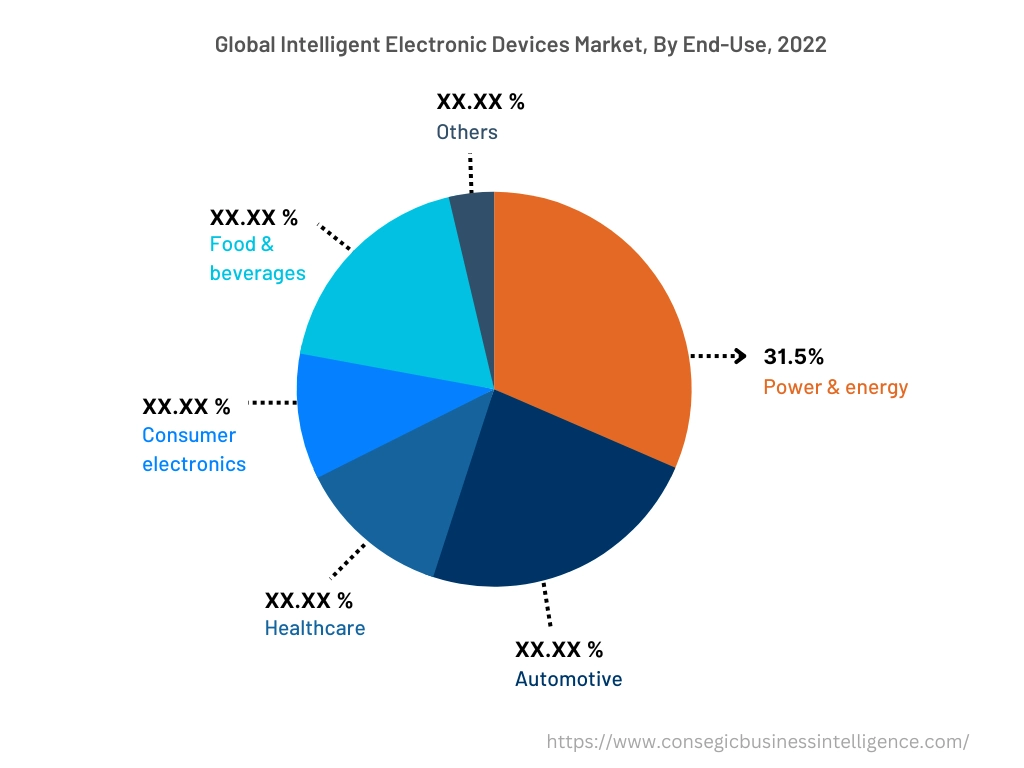
By Region :
The regional segment includes North America, Europe, Asia Pacific, Middle East and Africa, and Latin America.
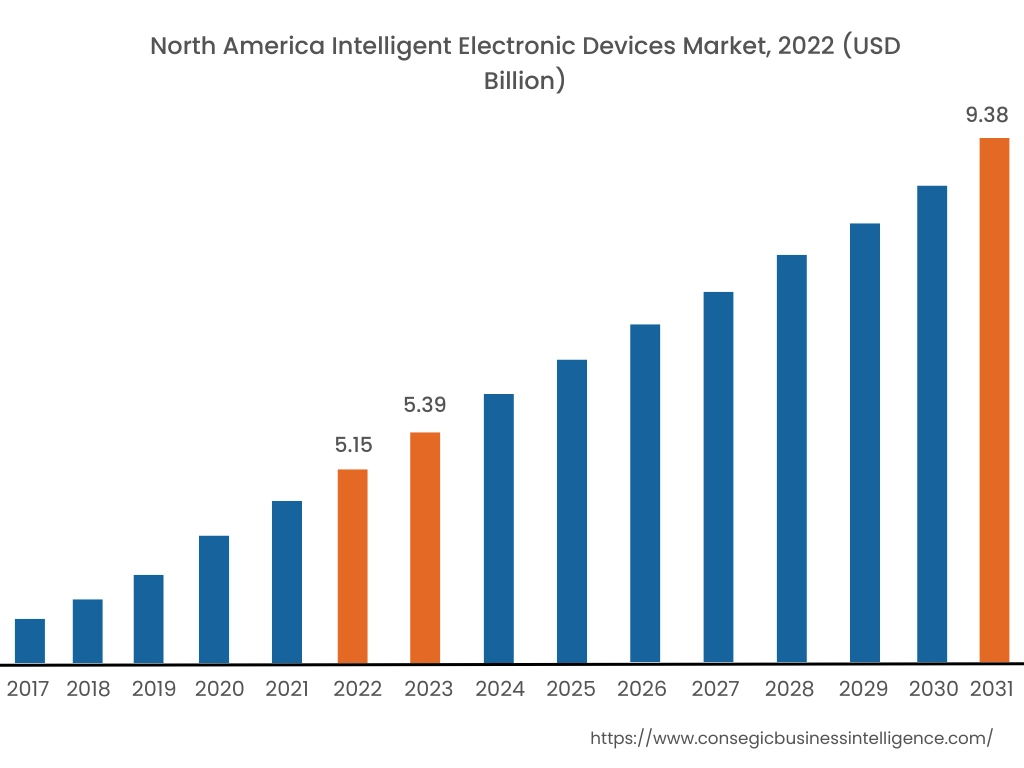
North America accounted for the largest revenue share of USD 5.15 Billion in 2022 and is expected to reach USD 9.38 Billion by 2031, growing by a CAGR of 7.2%. In addition, in the region, the U.S. accounted for the maximum revenue share of 51.45% in the same year.
The adoption of intelligent electronic devices in North America is primarily driven by factors including well-established power infrastructure, increasing need for enhanced reliability, regulatory support, and others. North America has a well-developed and robust power infrastructure, which provides a foundation for the adoption of IEDs. Analysis of intelligent electronic devices market trends concludes that the existing infrastructure is readily suitable to upgrade to accommodate IEDs coupled with large numbers of skilled workers availability is driving the market proliferation in the region. In addition, the North American regulatory environment is supportive of their adoption. In addition, the North American Electric Reliability Corporation (NERC) has issued standards for their application, and there are financial incentives available for utilities that adopt these devices.
Moreover, Asia-Pacific is expected to register the fastest CAGR growth of 7.4% during the forecast period. Analysis of intelligent electronic devices market trends concludes that the intelligent electronic devices market in the Asia-Pacific region is expected to grow significantly during the forecast period. The proliferation is attributed to several factors, including the increasing need for renewable energy, rapid urbanization, increasing investment in smart grid technologies, and government support. The Asia Pacific region is urbanizing rapidly, resulting in massive demand for electricity thus leading to a rise in pressure on the power grid. IEDs will thus help to improve the efficiency of the grid and reduce losses, which is essential to meet the increasing need for electricity.
Moreover, Asia Pacific is projected to be a major hub for the renewable energy market, and this is expected to continue to grow during the forecast period. IEDs will help to integrate renewable energy sources into the grid, which is essential to meet the increasing need for clean energy in the region.
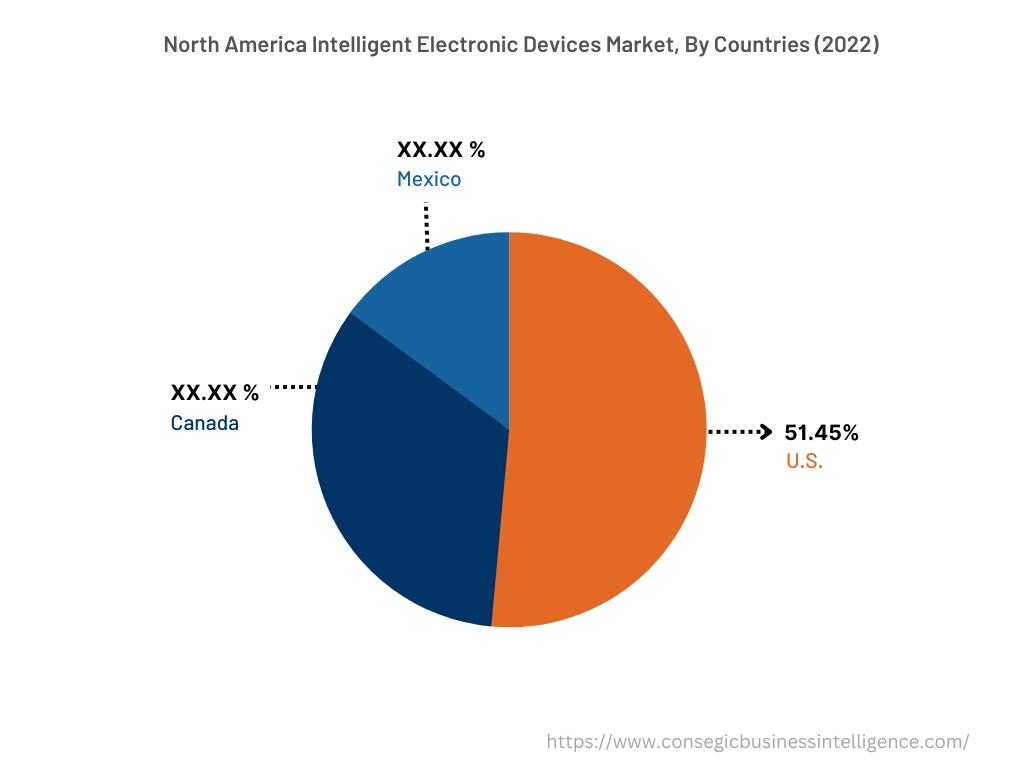
Top Key Players & Market Share Insights:
The intelligent electronic devices market is highly competitive with major players providing products to the national and international markets. Assessment of market trends suggests that the companies operating in the intelligent electronic devices industry are adopting several strategies in research and development (R&D), product innovation, and end-use launches to hold a strong position in the intelligent electronic devices market. Key players in the intelligent electronic devices market include-
- Hitachi Energy Ltd.
- Rockwell Automation Inc.
- Schneider Electric
- Cisco
- Toshiba Corporation
- Black & Veatch Corporation
- Eaton Corporation Inc.
Recent Industry Developments :
- In February 2023, Toshiba Electronic Devices & Storage Corporation, a leading manufacturer in the industry launched TPD2015FN and TPD2017FN, two intelligent power devices with capabilities to control the drive of the inductive loads of motors and lamps.
Key Questions Answered in the Report
What is Intelligent Electronic Devices? +
Intelligent electronic devices (IEDs) are commonly termed as a group of electronic devices incorporated into Industrial Control Systems (ICS) structures that allow variable power automation capabilities. IEDs are mainly electric components with microprocessors including regulator devices and circuit controllers.
What specific segmentation details are covered in the intelligent electronic devices report, and how is the dominating segment impacting the market growth? +
For instance, by type segment has witnessed protection relays as the dominating segment in the year 2022, owing to its increasing demand from industries including automotive, telecommunication, and others.
What specific segmentation details are covered in the intelligent electronic devices market report, and how is the fastest segment anticipated to impact the market growth? +
For instance, by end use segment will witness automotive segment to grow at the fastest growth rate during the forecast period. The rising demand for IEDs to control the engine, transmission, and other components of the powertrain is expected to boost the market growth during the forecast period.
Which region/country is anticipated to witness the highest CAGR during the forecast period, 2023-2031? +
Asia-Pacific is anticipated to register fastest CAGR growth during the forecast period due to rapid pace of industrialization and demand for improved telecommunication infrastructure.
